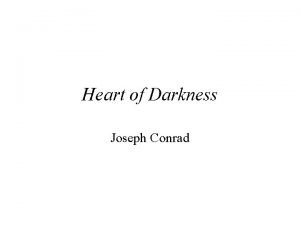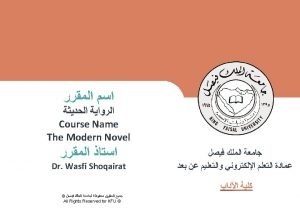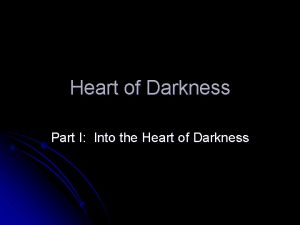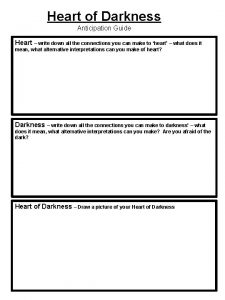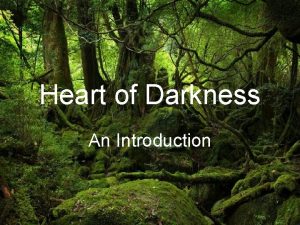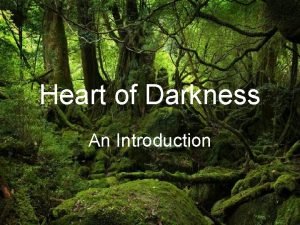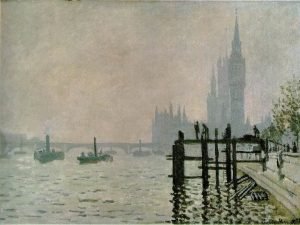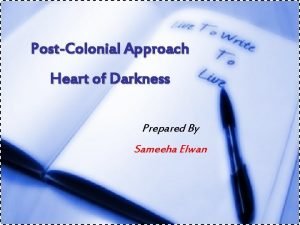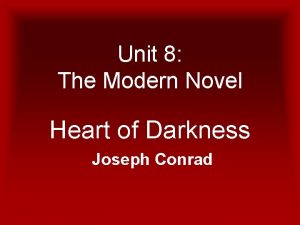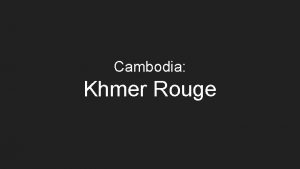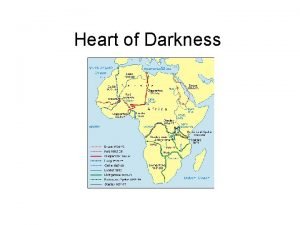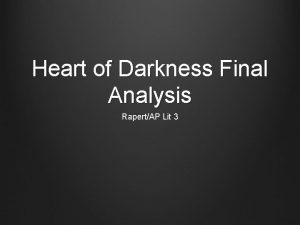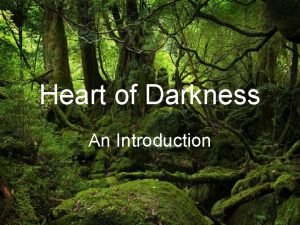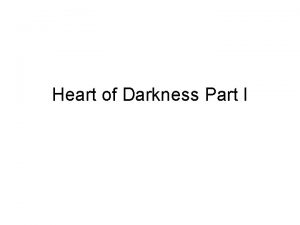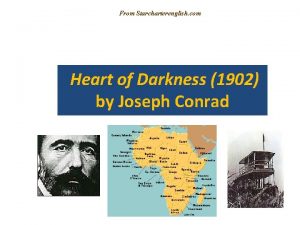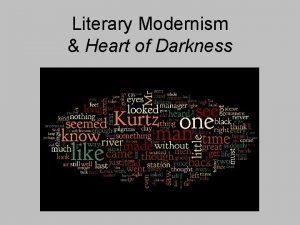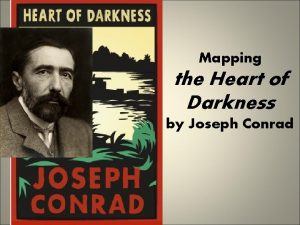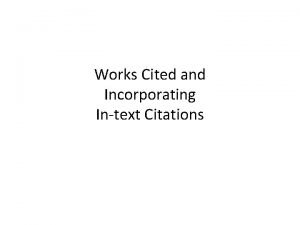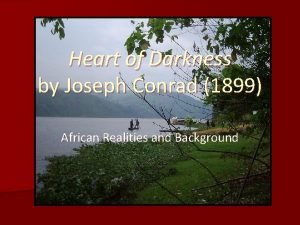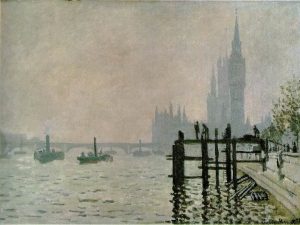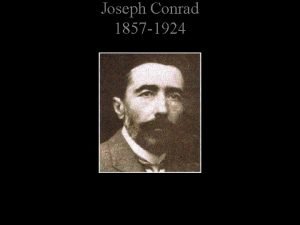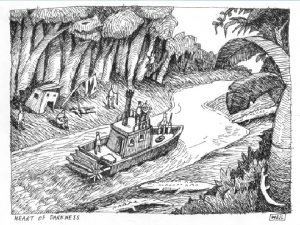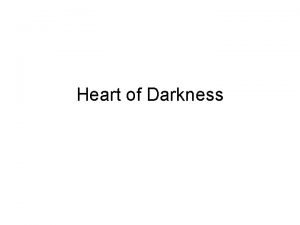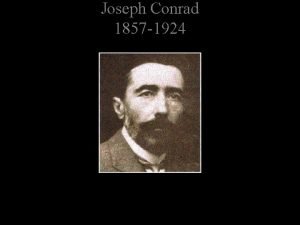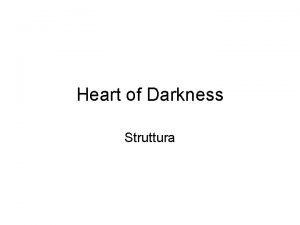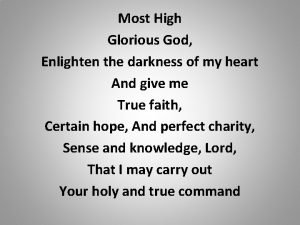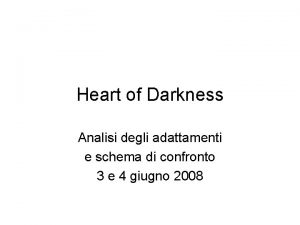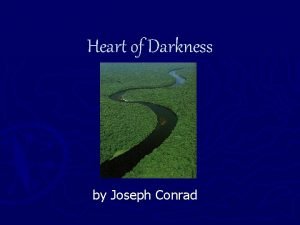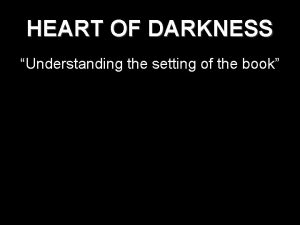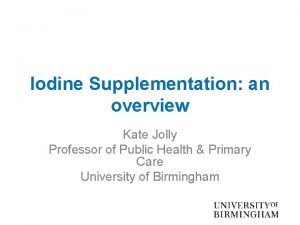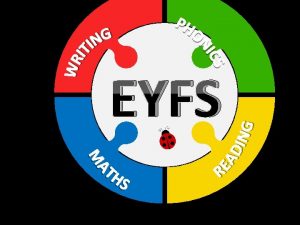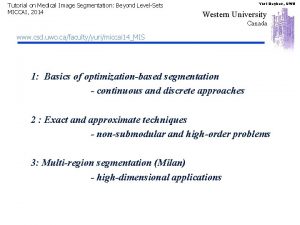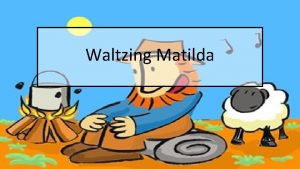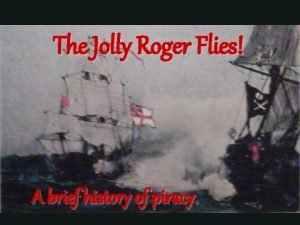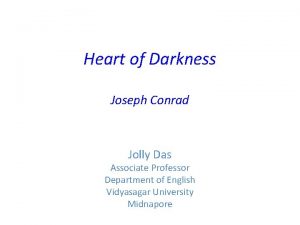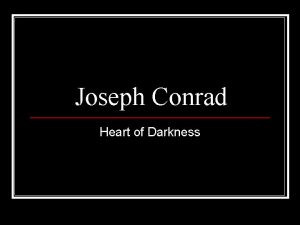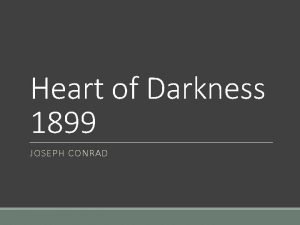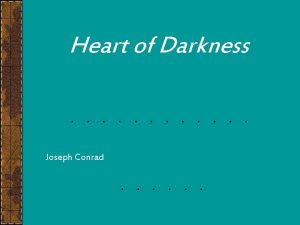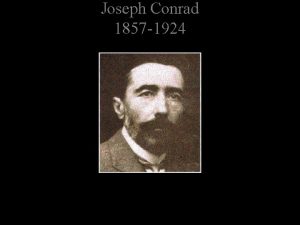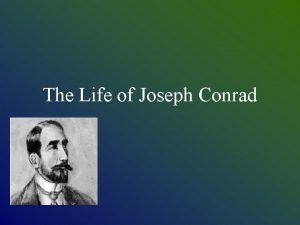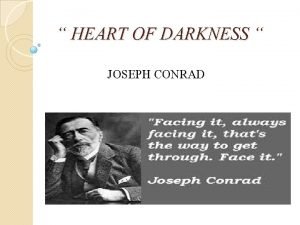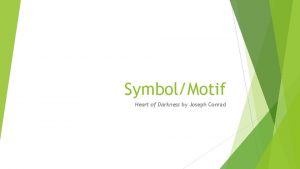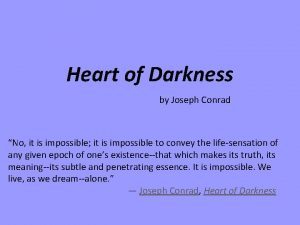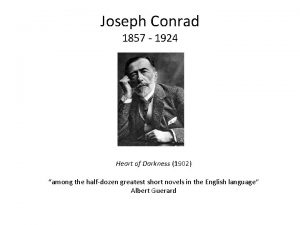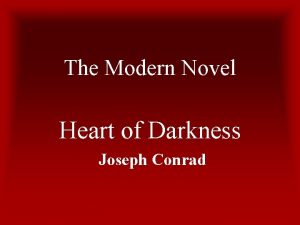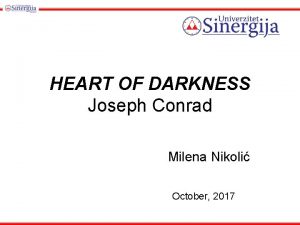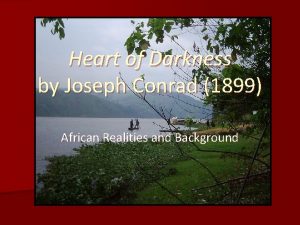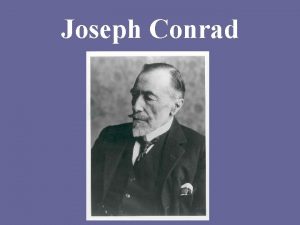Heart of Darkness Joseph Conrad Jolly Das Associate




















































![[Please note that the list is not exclusive] 1. Significance of the mist and [Please note that the list is not exclusive] 1. Significance of the mist and](https://slidetodoc.com/presentation_image_h/06dbbf8df1bbb6d46ffb8fe4ad235138/image-53.jpg)
![[Please note that the list is not exclusive] 2. The Russian adventurer • [Key [Please note that the list is not exclusive] 2. The Russian adventurer • [Key](https://slidetodoc.com/presentation_image_h/06dbbf8df1bbb6d46ffb8fe4ad235138/image-54.jpg)
![[Please note that the list is not exclusive] 3. The Intended • [Key Issues: [Please note that the list is not exclusive] 3. The Intended • [Key Issues:](https://slidetodoc.com/presentation_image_h/06dbbf8df1bbb6d46ffb8fe4ad235138/image-55.jpg)
![[Please note that the list is not exclusive] 4. The file of six men [Please note that the list is not exclusive] 4. The file of six men](https://slidetodoc.com/presentation_image_h/06dbbf8df1bbb6d46ffb8fe4ad235138/image-56.jpg)

![[Please note that the list is not exclusive] • All sections in bold in [Please note that the list is not exclusive] • All sections in bold in](https://slidetodoc.com/presentation_image_h/06dbbf8df1bbb6d46ffb8fe4ad235138/image-58.jpg)

- Slides: 59

Heart of Darkness Joseph Conrad Jolly Das Associate Professor Department of English Vidyasagar University Midnapore

Instructions • The contents of this presentation are the exclusive property of Vidyasagar University, Midnapore. They must not be used without seeking prior permission of the University authorities. • The contents are not answers to questions. They are lecture notes serving as guidelines for further study. • This presentation is in consonance with the Registrar’s Notification No. VU/R/Noti. /366/2020 dated 19. 03. 2020.


Acknowledgement • All the pictures / images have been borrowed from various available sources in the internet. • This is to humbly acknowledge my gratitude to all of them for facilitating the preparation of this presentation. • A special thanks to Wikipedia for information on the author and the text. • This Part is heavily indebted to the Introduction by Paul O’Prey. (Heart of Darkness. Edited with an Inroduction by Paul O’Prey. London: Penguin, 1985)

Heart of Darkness PART -- 2

‘Journey’ motif in Heart of Darkness

• The novella, Heart of Darkness makes judicious use of the motif of journey. • This motif is employed on various levels. • These levels can be cognized separately; yet, they are entwined in the narrative in order to offer a holistic appeal to the reader.

• 1. Very sketchily put, some of the obvious strands are: Conrad’s voyage up the Congo river in 1890, when he was serving a Belgian trading company. He had to sail from one station to another. The captain fell ill. So, Conrad had to take command. He guided the ship up the tributary Lualaba River to the trading company’s innermost station, Kindu. 2. Marlow’s voyage up the Congo river in the novella. Learning Material: The Journey to the Inner Station. Bernard J. Paris. [Harold Bloom. PDF. p/ 131] 3. Marlow’s inner / spiritual journey. 4. Marlow’s journey to visit the Intended.

Conrad’s voyage up the Congo river in 1890

The personal element: Conrad’s voyage up the Congo river in 1890 • Conrad’s trip to the Congo Free State, up the Congo river was disastrous. He returned with an enormous sense of disillusion and failure. The extreme personal crisis he underwent there which was so shocking that he experienced a moral and emotional transformation towards a deeper understanding of life as a human being. His interest in his vocation as a writer was strengthened. He decided to quit the life of a sailor and concentrate on his writing.

• As a boy Conrad shared his father’s romantic temperament and dreamed of travel and adventure. • Conrad gives Marlow the same boyhood dream about the Congo and it is while looking for a new ship’s command that Marlow remembers it, as well as what he had heard of a large Commercial Company trading on the river, and decides to try to get work there. • Henry Morton Stanley, the writer and explorer, who had found the missing missionary Dr. Livingstone in 1871, had, in the mid seventies, explored the jungles of central Africa and traced for the first time the course of the Congo river, penetrating right into the heart of ‘the dark continent’.

Present-day Congo Map of Congo river


• Stanley’s revelation of the commercial possibilities of the region had resulted in the setting up of a large trading venture and led to the founding of the Congo Free State, all of which was arranged and funded by King Leopold II of Belgium. • By the time Conrad reached the Congo it had become the virtual private property of Leopold II and the good work accomplished in the name of Christianity and Progress had been all but forgotten in the stampede of fortune-hunters. • This had resulted in what were, perhaps, the most appallingly greedy, cruel and hypocritical acts of colonial exploitation of the nineteenth century and what Conrad, in his essay, ‘Geography and Some Explorers’, called “the vilest scramble for loot that ever disfigured the history of human conscience and geographical exploration”. [Learning Material: ‘Geography and Some Explorers’. Full Text in Part—III of this presentation]

• Through the influence of his aunt, Margaret Podarowska, a novelist, Conrad secured a job with the Société Anonyme Belge pour le Commerce du Haut-Congo (SAB) as captain of a steamboat which would take an exploring expedition to Katanga, led by Alexandre Delcommune, brother of the SAB manager at Kinchassa. • This prospect pleased the adventurous Conrad as it seemed he would thus have a part in the Stanley-inspired exploration of the interior. • However when Conrad arrived in Kinchassa there arose an immediate antagonism between him and the manager, Camille Delcommune. • It seems that Delcommune was angered at Conrad’s delay in reaching Kinchassa from Matadi and Conrad was deeply offended by Delcommune’s cold reception.

• The boat which Conrad should have commanded was damaged. • After one or two days Conrad set off with Camille Delcommune on a different boat, the Roi de Belges, with Conrad as supernumerary to observe and learn the navigation of the river from an experienced captain. • The trip was a routine business. • Agent Klein, who was sick with dysentery at Stanley Falls, died on the downriver journey. • Klein had no resemblance with Kurtz. • Kurtz was based on a man called Hodister, who was a very successful company agent and explorer. • However, he did not have “an unlawful soul” like Kurtz; he was not a “man-god” among the savages. • He was a rival of Delcommune.

Conrad may have voyaged in a barge like this one…. . An Impressionistic Painting

• When Conrad, who much of this time had been sick with fever and dysentery, returned to Kinchassa, he was made to realize by Camille Delcommune that he would not be taking charge of the Katanga exploring party’s boat nor would he even he captaining a river steamboat. • Soon afterwards Conrad became seriously ill and left the Congo, returning to Brussels with a bitter sense of failure. • During the Congo episode, however, Conrad did experience a similar sense of enlightenment to Marlow and underwent a process of maturing through disillusion and defeat, a kind of defect which “brought him to the brink of existence, his own rather than that of civilization” (Frederick Karl, p. 301). • This produced in him a wider and deeper understanding of men, particularly of their darker side.

• Conrad knew about the recruitment of indigenous workmen to build a railroad to bypass the lower 220 miles of the Congo River. What it was like may be understood by viewing the video: Congo’s Lost Railway • [Learning Material: You. Tube link]: https: //www. google. com/imgres? imgurl=https%3 A%2 F%2 Fi. ytimg. com%2 Fvi%2 FUXp. G 9 EQYMnk%2 Fhqdefault. jpg&imgrefurl=https%3 A%2 F%2 Fww w. youtube. com%2 Fwatch%3 Fv%3 DUXp. G 9 EQYMnk&tbnid=zgwi 9 DWYK 5 X z 9 M&vet=12 ah. UKEwj 4 op. D 2 hb 3 o. Ah. V 35 XMBHXg. PA 1 IQMygzeg. QIARAw. . i& docid=i 1 Ccs 5 KM 126 NM&w=480&h=360&q=Congo%20 free%20 state%20 railway%20 line %20 construction%20 image&ved=2 ah. UKEwj 4 op. D 2 hb 3 o. Ah. V 35 XMBHXg. PA 1 IQMygzeg. QIARAw

Picture of a Station with natives milling around Congo Free State

• The pictures of the Congo river and its surrounding areas during the time of the Congo Free State can be compared to those of the Thames river and its surroundings. [the following slides (two) have some such pictures of the Thames in Conrad’s contemporary times] • This will enable you to have an understanding of where the narrator and his listeners were, as they were transported by the narrative to a distant geographical location—the Congo and its intimidating, mysterious surroundings, posing as a challenge to the adventurer and the colonizer.

The Thames, possibly at the turn of the century, when Heart of Darkness was being written

Impressionistic Painting: Thames river

Marlow’s voyage up the Congo river in the novella.

• Heart of Darkness is a novella written in 1899, when the nineteenth century was about to make way for the twentieth century. • Written at this juncture in chronological time, the novella is read as a work of modern fiction. • The protagonist, Charles Marlow, narrates a voyage up the River Congo, in the heart of Africa, the Dark Continent, into the Congo Free State (under the tyrannical governance of King Leopold II of Belgium).

• Conrad carefully creates the setting for Marlowe’s story in the very first paragraph of the novel. A group of people are on board the cruising yawl, Nellie, waiting for the tide to turn for it to make its downstream journey on the Thames. • The Thames is described thus: The old river in its broad reach rested unruffled at the decline of day, after ages of good service waterway leading • done to the race that peopled its banks, spread out in the tranquil dignity of a to the uttermost ends of the earth. The Congo, on the other hand, according to Marlow, is: “– fascinating – deadly –like a snake. ” • Marlow, seated like the Buddha on the cruising yawl Nellie, on the River Thames, in England, unfolds the narration of his experience in the Congo Free State to a small group (read the text for information on who they were) on the yawl, as the day draws to a close, ushering the darkness of night.

Picture of a Yawl

Thames river

Congo river "resembling an immense snake uncoiled, with its head in the sea, its body at rest curving afar over a vast country and its tail lost in the depths of the land"

• Although his own experiences are the raw material for the story, Conrad, in an attempt to express in fiction his development from idealism to disillusion and greater understanding, distorted actual experience in several ways. • Firstly, he made Marlow skeptical from the beginning, as we see in his hesitation and suspicion of the enterprise in Brussels, whereas for Conrad the opportunity to go to the Congo was full of idealistic and romantic eagerness. • Secondly, Marlow has a much more significant and functional role in the story than Conrad, who was never more than an observer and listener to gossip and who probably got the idea for the character of Kurtz from a newspaper report on Hodister’s death in 1892, after Conrad had long returned from the Congo. By making Marlow the captain of the boat, Conrad makes him directly responsible for the rescue of Kurtz (as well as for the lives of everyone on board) and thus gives the first-person narrative of the tale by Marlow greater force and immediacy.

• Thirdly, he exaggerated the isolation and primitiveness of the Congo by pre-dating it, so that “large settlements disappear, to be replaced by native villages and small, lost trading posts” and “navigation is a matter of discovering the right channel, feeling one’s way through an unknown waterway” (Sherry 343), whereas the Congo Conrad knew was quite a busy river. • Fourthly, he gives the journey into the heart of darkness a mythical quality and makes it an objective correlative for Marlow’s spiritualemotional development. [this is elaborated in the section on Marlow’s inner / spiritual journey in this presentation]

• Conrad makes necessary changes in his personal experiences in order to make the novella more intricate with a meaning of its own. • Some of these changes are: • Marlowe was held up for three months, whereas Conrad was detained for only two or three days. • Conrad portrays Camille Delcommune spitefully in the story and blames him, because of his half-deliberate delays, for the failure of the rescue party to reach Kurtz in time to save him.

• Further Reference: The Journey to the Inner Station. Bernard J. Paris. In Harold Bloom. PDF. p/ 131 [In Part I of this presentation] • Learning Material link: https: //www. bartleby. com/essay/Marlow-Journey-in-the-Congo-in-Heart. F 3 JWCSGATJ

Marlow’s journeys on land • Marlow’s journey to visit the Office of the Trading Company in Brussels. • Marlow’s journey to visit the Intended.

Marlow’s journey to visit the Office of the Trading Company in Brussels

• At the beginning of the narrative. • After getting his appointment, Marlow crossed the English Channel, to go to meet his employers and sign the contract. • Brussels appeared to him as a city which makes him think of a “whited sepulchre”. • He describes his journey in Brussels in this manner: “A narrow and deserted street in deep shadow, high houses, innumerable windows with venetian blinds, a dead silence, grass sprouting between the stones, imposing carriage archways right and left, immense double doors standing ponderously ajar. I slipped through one of these cracks, went up a swept and ungarnished staircase, as arid as a desert, and opened the first door I came to. . ”

• “Two women, one fat and the other slim, sat on straw-bottomed chairs, knitting black wool”, says Marlow. • In hindsight, he has a different perspective of the mechanical ushering in of robust young men who were about to go to the dark continent. • Now he has realized that many of them would never return. • This insightful observation made by Marlow at the early stage of his narrative adds the element of unpredictability and transient nature of human existence. • The journey which he was about to begin (re-visited in retrospect) gets a deeper significance as a result of the addition of this section of the narrative.

Marlow’s journey to visit the Intended

• This journey is made at the fag end of Marlow’s narrative. • The character of Kurtz is almost as enigmatic as the darkness in which he dwells. For Marlow, as for us, Kurtz remains a rumour, or a ‘word’ or, more strongly at the end, a ‘voice’. He is never a real character. • Marlow says about him, “Everything belonged to him [Kurtz]—but that was a trifle. The thing was to know what he belonged to, how many powers of darkness claimed him for their own. That was the reflection that made you creepy all over. It was impossible—it was not good for one either—trying to imagine. ” • Marlow ‘s journey to the ‘Intended’ is justified by his responsibility to hand over to her “a slim packet of letters and the girl’s portrait. ” • He narrates: “I concluded I would go and give her back her portrait and those letters myself. Curiosity and also some other feelings perhaps. ”

• He goes on to give his reason for this: • “All that had been Kurtz’s had passed out of my hands: his soul, his body, his station, his plans, his ivory, his career. There remained only his memory and his Intended—and I wanted to give that up, too, to the past, in a way—to surrender personally all that remained of him with me to that oblivion which is the last word of our common fate. ” • The journey to the Intended is not described at all. Yet his telling that he had to “wait in a lofty drawing-room “ meant only one thing—Marlow had made that journey. • It is strange that Conrad does not describe this journey. It cannot be that he forgot to do so. It is left alone on purpose. The unsaid, yet implied, is more enigmatic, more mysterious, than that which is stated clearly. Thus, this technique is employed by Conrad.

• This may be justified by what Conrad wrote, on 31 May 1902, in a letter to William Blackwood, where Conrad remarked: “I call your own kind self to witness. . . the last pages of Heart of Darkness where the interview of the man and the girl locks in—as it were—the whole 30000 words of narrative description into one suggestive view of a whole phase of life and makes of that story something quite on another plane than an anecdote of a man who went mad in the Centre of Africa. ”

Marlow’s inner / spiritual journey

• Conrad “gives the journey into the heart of darkness a mythical quality and makes it an objective correlative for Marlow’s spiritual-emotional development. ” (Paul O’Prey, Introduction. Heart of Darkness. London: Penguin, 1983) • Many critics have seen it as a journey into (1) Marlow’s subconscious, (2) a ‘general’ subconscious, (3) a psychological-anthropological ‘night journey’ (Albert J Guerard) by which term he means: the archetypal myth dramatized in much great literature since the Book of Jonah: the story of an essentially solitary journey involving profound spiritual change in the voyager. In its classical form the journey is a descent into the earth, followed by a return to light. (“The Journey Within”) [Learning Material: Essays on Conrad. Link: www. ljhammond. com>phlit>toc ] [Further reading on this issue: ‘The Secret Sharer’. Conrad]

• Marlow prepares us for such a journey in his prologue: It was the furthest point of navigation and the culminating point of my experience. It seemed somehow to throw a kind of light on everything about me—and into my thoughts. . I felt as though, instead of going to the centre of a continent, I were about to set off for the centre of the earth. • Thus as well as a physical journey, an ‘adventure’, it is a psychological and mystical journey and by avoiding the proper names, replacing Matadi with the ‘Company Station’ Kinchassa with the ‘Central Station’ Stanley Falls with the ‘Inner Station’ • Conrad emphasized the sense of penetration to some sort of mystery.

• The atmosphere of a ‘night journey’ is further developed by suggestions that the Congo moves temporally as well as spatially, so that: “Going up that river was like going back to the beginnings, when vegetation rioted. . . And the big trees were kings. ” • Marlow feels as he watches and listens to the frenzied natives on the banks that he cannot understand them “because we were too far and could not remember, because we were travelling in the night of first ages, of those ages that are gone, leaving hardly a sign and no memories”, though he admits there was in him “just the faintest trace of a response to the terrible frankness of that noise”.

• Critics have discussed in detail about the exact nature of the “darkness”. • The darkness is many things: it is the unknown, it is the subconscious; it is also a moral darkness, it is the evil which swallows up Kurtz and it is the spiritual emptiness he sees at the centre of existence; but above all it is mystery itself, the mysteriousness of man’s spiritual life. • Marlow realizes that he is incapable of understanding the secrets of the darkness, and that the price of understanding is the soul-madness of Kurtz. He decides that it is better not to delve too deep into the mystery, like Kurtz, because like Kurtz, he may have nothing more than Kurtz’s “The horror!” to articulate.

• Marlow’s experience of an inner journey (his spiritual journey) • Learning Material Links: • http: //jtknk. tripod. com/alverez. htm • https: //www. bachelorandmaster. com/britishandamericanfiction/heart-ofdarkness-a-journey-within. html • https: //www. jstor. org/stable/20873744? Search=yes&result. Item. Click=true&se arch. Text=Conrad&search. Text=Heart&search. Text=of&search. Text=Darkness&s earch. Text=Journey&search. Uri=%2 Faction%2 Fdo. Basic. Search%3 FQuery%3 DCo nrad%2 BHeart%2 Bof%2 BDarkness%2 BJourney&ab_segments=0%2 Fbasic_SYC -5055%2 Fcontrol&refreqid=search%3 A 9 ec 6 d 043 b 233 aa 7 ba 34870996485 cba 5 • Essays on Conrad. www. ljhammond. com>phlit>toc

Conclusion Written in the last year of the nineteenth century (a commission for the thousandth issue of Blackwood’s magazine), Heart of Darkness can be seen as the first twentieth-century novel, with its climate of doubt and vagueness, its loss of moral confidence, its need for ‘belief’ in the midst of moral wilderness. Its exploration of the subconscious, and its affirmation of individual freedom.

• Marlow ends his narrative. • Conrad picks up. • The authorial voice, which had begun the novella, ends it in this way: . . . And the tranquil waterway leading to the uttermost ends of the earth flowed sombre under an overcast sky—seemed to lead into the heart of an immense darkness. • The river-metaphor of life flows on. . .

Preparing for the forthcoming end-semester examination. . .

For Long Answers • Read the entire text very closely. • Follow the presentation—all the parts.

For Comments
![Please note that the list is not exclusive 1 Significance of the mist and [Please note that the list is not exclusive] 1. Significance of the mist and](https://slidetodoc.com/presentation_image_h/06dbbf8df1bbb6d46ffb8fe4ad235138/image-53.jpg)
[Please note that the list is not exclusive] 1. Significance of the mist and haze in Heart of Darkness • [Key ideas: expressionistic representation of mist and haze; what they signify literally; what they signify metaphorically] • Learning Material: “The Fogginess of Heart of Darkness”. Sydney Open Journals Online. https: //openjournals. library. sydney. edu. au [PDF]
![Please note that the list is not exclusive 2 The Russian adventurer Key [Please note that the list is not exclusive] 2. The Russian adventurer • [Key](https://slidetodoc.com/presentation_image_h/06dbbf8df1bbb6d46ffb8fe4ad235138/image-54.jpg)
[Please note that the list is not exclusive] 2. The Russian adventurer • [Key issues: Who he is; where is he found in the narrative; why, do you think, has Conrad used him; Marlow’s attitude to him] • Learning Material: “Conrad’s Pesky Russian” – jstor • https: //www. jstor. org
![Please note that the list is not exclusive 3 The Intended Key Issues [Please note that the list is not exclusive] 3. The Intended • [Key Issues:](https://slidetodoc.com/presentation_image_h/06dbbf8df1bbb6d46ffb8fe4ad235138/image-55.jpg)
[Please note that the list is not exclusive] 3. The Intended • [Key Issues: Who is she; her role in the novella; Marlow’s attitude to her] • Learning Material: “Kurtz’s Intended: The Heart of Darkness” – jstor • https: //www. jstor. org
![Please note that the list is not exclusive 4 The file of six men [Please note that the list is not exclusive] 4. The file of six men](https://slidetodoc.com/presentation_image_h/06dbbf8df1bbb6d46ffb8fe4ad235138/image-56.jpg)
[Please note that the list is not exclusive] 4. The file of six men in chains with small baskets on their heads • [Key Issues: Who are they; their role in the novella; Marlow’s attitude to them] • Learning Material: “Heart of Darkness and the Ends of Man. ” Daphna Erdinast-Vulcan. The Conradian. Vol. 28, No. 1 (Spring 2003) pp. 17 -33. link: https: //www. jstor. org/stable

For Short Answers
![Please note that the list is not exclusive All sections in bold in [Please note that the list is not exclusive] • All sections in bold in](https://slidetodoc.com/presentation_image_h/06dbbf8df1bbb6d46ffb8fe4ad235138/image-58.jpg)
[Please note that the list is not exclusive] • All sections in bold in the presentation. • The information related to the publication of Heart of Darkness. • The persons on board the Nellie. • The “sepulchral city”

Continued in Part - III
 The summary of heart of darkness by joseph conrad
The summary of heart of darkness by joseph conrad Heart of darkness summary part 2
Heart of darkness summary part 2 Impressionistic writing definition
Impressionistic writing definition Heart of darkness deaths
Heart of darkness deaths Heart of darkness shmoop
Heart of darkness shmoop Heart of darkness impressionism
Heart of darkness impressionism Heart of darkness introduction
Heart of darkness introduction Journey without maps
Journey without maps Edward said two visions in heart of darkness
Edward said two visions in heart of darkness Heart of darkness as a modern novel
Heart of darkness as a modern novel Heart of darkness cambodia
Heart of darkness cambodia Heart of darkness map
Heart of darkness map Heart of darkness deaths
Heart of darkness deaths Heart of darkness as a modern novel
Heart of darkness as a modern novel Heart of darkness part 2
Heart of darkness part 2 Heart of darkness theme
Heart of darkness theme Heart of darkness modernism
Heart of darkness modernism Map of the heart darkness
Map of the heart darkness Heart of darkness mla citation
Heart of darkness mla citation Themes heart of darkness
Themes heart of darkness Heart of darkness map
Heart of darkness map Heart of darkness slavery quotes
Heart of darkness slavery quotes Heart of darkness lesson plans
Heart of darkness lesson plans Setting of heart of darkness
Setting of heart of darkness Rivets heart of darkness
Rivets heart of darkness Symbols heart of darkness
Symbols heart of darkness Tim roth heart of darkness
Tim roth heart of darkness O most high and glorious god
O most high and glorious god Heart of darkness soluzioni
Heart of darkness soluzioni Heart of darkness diction
Heart of darkness diction Setting of heart of darkness
Setting of heart of darkness Jolly phonics
Jolly phonics Hemicromo
Hemicromo Virginia elks association
Virginia elks association Kate jolly
Kate jolly Simon jolly
Simon jolly Jolly dipper menu
Jolly dipper menu Jolly st ermins
Jolly st ermins Kate jolly
Kate jolly Jolly phonics p
Jolly phonics p Simon jolly
Simon jolly Hemácias em alvo
Hemácias em alvo Sandeep singh jolly
Sandeep singh jolly Jolly phonics o story
Jolly phonics o story Jolly med
Jolly med Simon jolly
Simon jolly Jolly phonics d
Jolly phonics d Functional segmentation
Functional segmentation Rbc inclusions
Rbc inclusions Jolly character in waltzing matilda
Jolly character in waltzing matilda Oecd space forum
Oecd space forum Jolly tota
Jolly tota Simon jolly
Simon jolly Jolly phonics f
Jolly phonics f Devil stabbing heart flag
Devil stabbing heart flag Ich bin die wahrheit und das licht
Ich bin die wahrheit und das licht Das alte ist vergangen das neue angefangen
Das alte ist vergangen das neue angefangen O menosprezo das artes e das letras
O menosprezo das artes e das letras Eu fico com a pureza das cri
Eu fico com a pureza das cri Das alles ist deutschland das alles sind wir
Das alles ist deutschland das alles sind wir
